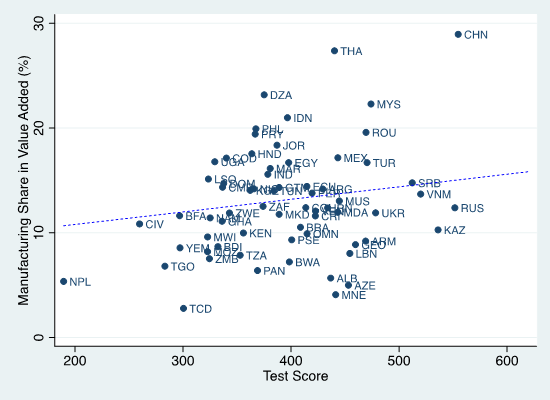IDE Research Columns
Column
Why Is Quality Education Crucial to Industrialization in a Post-Pandemic World?

Hitoshi SATO
Institute of Developing Economies, JETRO
April 2022
The COVID-19 pandemic has caused serious disruptions in education, potentially complicating industrialization, a long-standing challenge for developing countries. This column presents the risk of industrialization stagnation in developing countries due to poor education systems and the consequent low social mobility. Manufacturing automation, which may be accelerated further as a result of the pandemic, can assist developing countries in industrial upgrading. However, poor education systems limit the supply of labor with appropriate skills and make the welfare effect ambiguous, thereby widening the wage gap between skilled and unskilled labor. The growing fiscal burden caused by the COVID-19 crisis may leave small policy room, but improving education systems should be prioritized.
Uncertain Long-run Recovery from the COVID-19 Crisis
The world economy is on a fragile recovery path from the COVID-19 crisis as recent growth projections indicate a recovery deceleration. Nonetheless, the recovery trajectory is expected to be more optimistic than what we saw following the great financial crisis of 2008 (e.g., World Bank 2022). The main reason for this is that the COVID-19 crisis is primarily a health crisis, and fundamental economic systems, such as financial institutions, are largely unaffected (e.g., Mc Morrow et al. 2021).
Meanwhile, the prospect of the long-run growth looks much bleaker, particularly for poor developing economies. Even if their economies recover to pre-pandemic levels, they will face a long-standing challenge, namely, economic development through industrialization, which will be exacerbated by the COVID-19 crisis. For example, UNESCO’s statistics reveal that school closures, including partial closures, reached more than 38 weeks on average during the first 20 months of the pandemic, with developing economies faring worse.i The standard schooling lasts 35 to 45 weeks per year; thus, serious school closures must have increased households’ burden on education and exaggerated learning inequality, as evidenced by the accessibility gap in quality online learning. Education was severely harmed during the pandemic, which is likely to leave a long-lasting scar on economic growth, degrading human capital in the long-run.ii
Important Industrialization after the COVID-19 Pandemic
Long before the pandemic, industrialization was at the center of developing countries’ development strategies, with the expectation of technological progress, access to global markets, and creation of better jobs. However, the results have been mixed at best: only a few countries have succeeded in industrialization, whereas others have been sluggish and have remained in nonindustrial states. Even countries that have been successful in launching industrialization are concerned about becoming entrapped in low-skill manufacturing activities and increasing shares of services (e.g., Rodrik 2016).
The COVID-19 pandemic appears to highlight the importance of industrialization for developing economies. It is now widely acknowledged that workers in the informal sector are more vulnerable to infection risk (because of the need for face-to-face interactions in their service provision) and suffer greater job and income loss than their formal counterparts. Thus, successful industrialization contributes to social resilience in an era of rising health concerns.
Sato (2021) proposes a simple open economy model with endogenous skill formation to demonstrate how the COVID-19 crisis would deprive developing economies of industrialization opportunities and increase the risk of industrialization stagnation. Furthermore, Sato (2021) investigates whether manufacturing automation would help developing economies move away from low-skill intensive activities and upgrade the industry, given the growing belief that the COVID-19 crisis will accelerate trends of manufacturing automation with machines replacing low-skill jobs (e.g., Seric and Winkler, 2020).
Education as an Industrialization Driver
According to the proposed model, the long-run impact of the COVID-19 crisis on developing economies could be greatly heterogeneous, depending on their socioeconomic environments, particularly country size and education efficiency. In particular, countries with a small workforce and a weak education system are prone to derailment from the path to industrialization.
For better understanding, consider a hypothetical open economy that specializes in non-tradable services and a tradable traditional good (e.g., agricultural or commodity goods). At given world prices, this economy exports a traditional good and imports a manufacturing good. Non-tradable services and traditional goods are both assumed to be unskilled-labor-intensive, and thus, the economy has no demand for skilled labor.
When the economy achieves manufacturing competitiveness in global markets, the process of industrialization begins. Assume that manufacturing production necessitates both unskilled labor (e.g., assembling) and skill intensive intermediate inputs (e.g., parts and equipment and technical services). Workers must obtain skills through costly education to participate in intermediate input production. Moreover, consider manufacturing scale economies: as more intermediate inputs become available to manufacturers, manufacturing becomes more efficient. Readers may consider the clusters of electronic parts and equipment in Shanzhen, China, as an example of how scale economies aid in the growth of the electronics industry.
Scale economies in manufacturing imply that a minimum size of intermediate production must exist for manufacturers to attract workers from the traditional good and non-tradable services sectors by offering competitive wages. Once this minimum size condition is met, a virtuous industrialization cycle begins: as workers enter the manufacturing sector, manufacturing productivity rises, and higher wages can be offered, attracting workers from other sectors. However, how does an unindustrialized economy obtain the minimum intermediate production at the outset? It is not easy at all because, in the nonindustrial state, given scale economies, each entrant firm finds intermediate production unprofitable, resulting in no entry into intermediate production (i.e., industrialization trap). Hosting multinationals that bring skill intensive intermediate inputs from abroad, as exemplified by export processing zones, is a common solution.
The model predicts that the long-run performance of such industrialization policies is critically dependent on education: poor education systems discourage domestic workers from acquiring skills and limit the development of local intermediate input firms, resulting in a low level of industrialization (e.g., less-skill intensive assembling). Figure 1 depicts the share of manufacturing in total value-added and educational performance in middle and low-income economies. International test scores of learning achievement in middle schools are used to assess educational performance. As shown in Figure 1, a positive correlation exists: countries with effective education systems have high manufacturing shares.

Figure 1 Industrialization and Education in Middle- and Low-Income Economies
Source: See the endnote for details about sources.iii
COVID-19 Disruption
Many developing countries’ educational attainment rates have steadily increased, but education quality has remained unsatisfactory (e.g., Hanushek, 2013). The COVID-19 crisis has undoubtedly exacerbated the situation by reducing both the quantity and quality of education. Aside from school closures, poor access environments for remote learning, public finance shortages, and household income declines all combine to deprive households of educational opportunities.
Efficient education systems that prepare workers to enter technologically advanced manufacturing activities compensate for a small labor force: with a better education system, even a small developing country can be industrialized (e.g., Korea, Singapore, and Taiwan). Thus, the pandemic would hurt developing countries’ manufacturing competitiveness and make industrialization more difficult, particularly in small countries with low education quality, implying heterogeneous long-run growth among developing economies.
Automation and Income Disparities
The COVID-19 crisis is likely to accelerate the trend of digitization and automation in reducing labor supply vulnerability, and this trend may persist even in developing countries that host unskilled manufacturing activities. Indeed, long before the pandemic, developing countries have observed manufacturing automation with local wage increases and machine progress.iv Sato (2021) finds the following automation effects:
- Automation would benefit society by encouraging industrialization, which expands the productive manufacturing sector and contracts the unproductive non-tradable sector.
- This bright scenario is critically dependent on both inter- and intra-sectoral labor mobilities, particularly the smooth acquisition of skills required for working with digitized production technology.
- Otherwise, manufacturing automation would result in an expansion of the non-tradable sector, creating an ambiguous welfare effect and increasing wage disparities between skilled and unskilled workforce.
In sum, high social mobility fueled by education is critical for reaping the benefits of automation. Many developing countries appear to lack such a characteristic, and with the COVID-19 crisis, the expansion of non-tradable services and widening domestic income gaps appear to be the most likely scenario for them.
Policy Implications
This column emphasizes that limited access to high-quality education hinders developing economies to capitalize on the opportunity for growth through industrialization. Furthermore, such economies are unable to reap the full benefits of technological progress, such as automation (digitization). Innate human capabilities such as conceptual thinking and social flexibility become more important, implying that school education, in addition to vocational training, is even more important for building quality human capital. Developing countries continue to lag far behind advanced economies in areas such as government expenditure on education. Although the growing fiscal burden caused by the COVID-19 crisis may leave small policy room, improving education systems should be prioritized.
Author’s note: The main research on which this column is based is: Sato, Hitoshi. 2021. “Industrialization of Developing Economies in the Global economy with an Infectious Disease.” The Developing Economies 59(2): 126-153.
References
Altinok, Nadir, Noam Angrist, and Harry A. Patrinos. 2018. “Global Data Set on Education Quality (1965-2015).” Policy Research Working Paper, no. WPS 8314 Washington, D.C. World Bank Group.
http://documents.worldbank.org/curated/en/706141516721172989/Global-data-set-on-education-quality-1965-2015
Hanushek, Eric A. 2013. “Economic Growth in Developing Countries: The Role of Human Capital.” Economics of Education Review 37: 204-212.
https://doi.org/10.1016/j.econedurev.2013.04.005
Mc Morrow, Kleran, François Blondeau, Francesca D’Auria, Björn Döhring, Atanas Hristov, Christoph Maier, and Anna Thum-Thysen. 2021. “Output Gaps, Potential Output and the Covid-19 Crisis: Policymaking under Uncertainty.” VOXEU CEPR.
https://voxeu.org/article/output-gaps-potential-output-and-covid-19-crisis
Rodrik, Dani. 2016. “Premature Deindustrialization.” Journal of Economic Growth 21: 1-33.
Sato, Hitoshi. 2021. “Industrialization of Developing Economies in the Global economy with an Infectious Disease.” The Developing Economies 59(2): 126-153.
https://doi.org/10.1111/deve.12280
Seric, Adnan and Deborah Winkler. 2020. “COVID-19 Could Spur Automation and Reverse Globalisation - To Some Extent.” VOX CEPR.
https://voxeu.org/article/covid-19-could-spur-automation-and-reverse-globalisation-some-extent
World Bank. 2022. January 2022 Global Economic Prospects.
https://www.worldbank.org/en/publication/global-economic-prospects (accessed March 15, 2021).
i The data is available at UNESCO’s “Global monitoring of school closures” at https://en.unesco.org/covid19/educationresponse#schoolclosures.
ii World Bank. 2019. “The Education Crisis: Being in School Is Not the Same as Learning.” https://www.worldbank.org/en/news/immersive-story/2019/01/22/pass-or-fail-how-can-the-world-do-its-homework (accessed on March 15, 2022).
iii Test scores are taken from Altinok, Angrist, and Patrinos (2018) and present the achievement of the secondary education. Manufacturing shares in total value-added are obtained from the World Development Indicators. The positive (and statistically significant) correlation illustrates in the figure remains after controlling the labor size. The result is robust for alternative sample countries composed of Asia, Africa, and Latin American countries.
iv Emont, Jon. 2018. “The Robots Are Coming for Garment Workers. That’s Good for the U.S., Bad for Poor Countries.” Wall Street Journal, February 16. https://www.wsj.com/articles/the-robots-are-coming-for-garment-workers-thats-good-for-the-u-s-bad-for-poor-countries-1518797631 (accessed on March 15, 2022).
* The views expressed in the columns are those of the author(s) and do not represent the views of IDE or the institutions to which the authors are attached.
** Thumbnail image: Schoolgirl looking at chalkboard with algebra sums, KwaZulu Natal Province, South Africa(Getty images)

